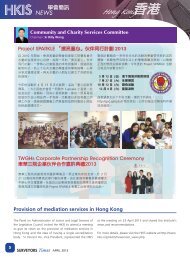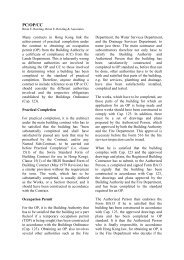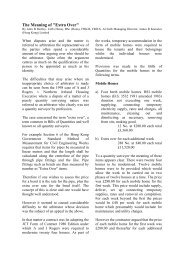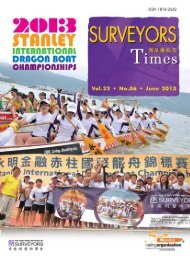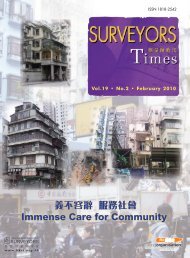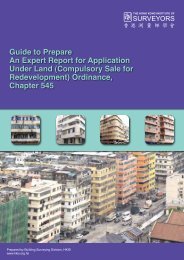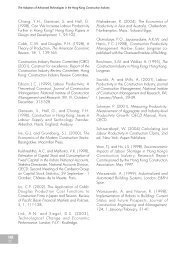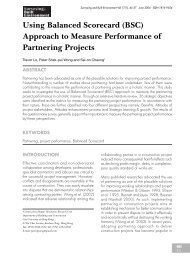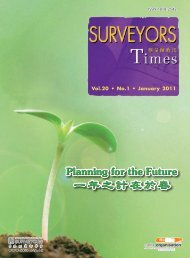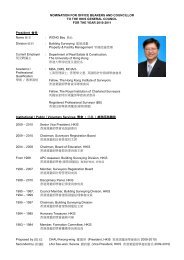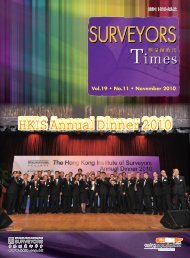Special issue to commemorate the 70th Anniversary of the Battle of ...
Special issue to commemorate the 70th Anniversary of the Battle of ...
Special issue to commemorate the 70th Anniversary of the Battle of ...
You also want an ePaper? Increase the reach of your titles
YUMPU automatically turns print PDFs into web optimized ePapers that Google loves.
“Pillbox 3 did not open fire!” Mapping <strong>the</strong> Arcs <strong>of</strong> Fire <strong>of</strong> Pillboxes at Jardine’s Lookout and Wong Nai Chung Gap<br />
Pho<strong>to</strong> 1 – The attack on Pillboxes 1 and 2<br />
Many <strong>of</strong> <strong>the</strong> casualties suffered by <strong>the</strong> Japanese<br />
attackers were inflicted by two pillboxes (PB 1 and<br />
PB2) held by No. 3 (Machine Gun) Company <strong>of</strong> <strong>the</strong><br />
HKDVC, which comprised mainly Eurasian Hong<br />
Kong citizens. A wartime painting by a Japanese artist<br />
(Pho<strong>to</strong> 1) showing Japanese soldiers fighting uphill,<br />
with Mount Nicholson and Wong Nai Chung Gap Road<br />
in <strong>the</strong> distant background <strong>to</strong> provide geographical<br />
context, obviously refers <strong>to</strong> <strong>the</strong>ir costly assaults on<br />
<strong>the</strong>se two pillboxes up from <strong>the</strong> Ride.<br />
Unlike o<strong>the</strong>r fighting elsewhere during <strong>the</strong> <strong>Battle</strong><br />
<strong>of</strong> Hong Kong, <strong>the</strong> dispositions <strong>of</strong> <strong>the</strong> defenders<br />
and invaders were recorded in two almost identical<br />
sketches (<strong>the</strong> smaller scale at 1:20000) in a war diary<br />
(“War Diary”) written by Major G. Evan Stewart, <strong>the</strong><br />
commander <strong>of</strong> No.3 Company <strong>of</strong> <strong>the</strong> HKVDC, while<br />
he was interned in a Japanese POW camp.<br />
This present work is however <strong>the</strong> first <strong>to</strong> provide<br />
accurately surveyed locations and measurements<br />
<strong>of</strong> <strong>the</strong> defensive structures <strong>of</strong> this major battlefield,<br />
some <strong>of</strong> which have been concealed by heavy postwar<br />
overgrowth, for <strong>the</strong> benefit <strong>of</strong> his<strong>to</strong>rians and military<br />
experts who are interested in <strong>the</strong> <strong>Battle</strong> <strong>of</strong> Hong Kong,<br />
but have never been able <strong>to</strong> evaluate certain aspects <strong>of</strong><br />
<strong>the</strong> battle scientifically due <strong>to</strong> <strong>the</strong> absence <strong>of</strong> accurate<br />
maps.<br />
PURPOSE<br />
This short paper represents <strong>the</strong> first pr<strong>of</strong>essional<br />
mapping exercise for <strong>the</strong> defensive structures on <strong>the</strong><br />
battlefield <strong>of</strong> Wong Nai Chung Gap during <strong>the</strong> <strong>Battle</strong> <strong>of</strong><br />
Hong Kong, with particular attention paid <strong>to</strong> <strong>the</strong> firing<br />
arcs <strong>of</strong> PBs1 <strong>to</strong> 3. Some <strong>of</strong> <strong>the</strong>se structures (save <strong>the</strong><br />
PBs) have never been marked on government survey<br />
maps.<br />
METHODS<br />
This exercise involved examining archival materials<br />
and aerial pho<strong>to</strong>s (in order <strong>to</strong> locate <strong>the</strong> structures for<br />
surveying), field trips and actual site measurements<br />
using standard land surveying <strong>to</strong>ols, and line <strong>of</strong> sight<br />
analysis. The starting point is <strong>the</strong> larger scale sketch<br />
by Major Stewart in his war diary. The only structures<br />
that we have not been able <strong>to</strong> ascertain are posts JLO<br />
1, 2, and 3 and those along <strong>the</strong> Ride. Those on (and<br />
including) Blue Pool Road, now buried under <strong>the</strong> Hong<br />
Kong Cricket Club grounds and reclaimed by 1972<br />
post war, were identified using aerial pho<strong>to</strong>s <strong>of</strong> 1949<br />
and 1963.<br />
The exercise shows how GIS techniques can be used<br />
for heritage mapping and explaining gaps in a battle’s<br />
his<strong>to</strong>ry.<br />
The authors visited <strong>the</strong> structures marked in <strong>the</strong> larger<br />
SBE<br />
44



